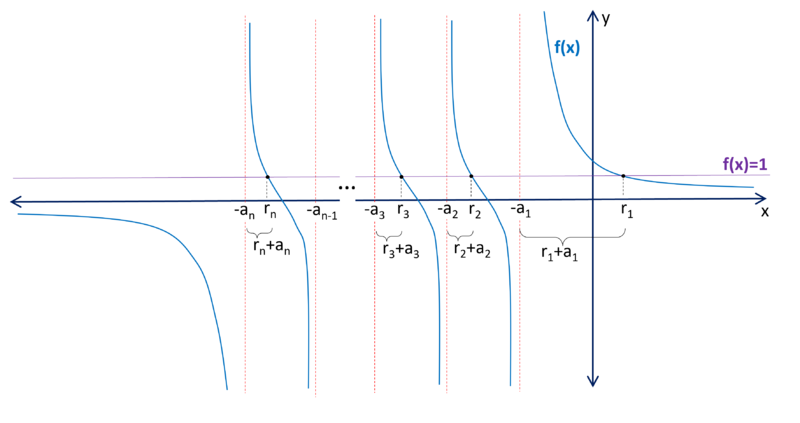Difference between revisions of "1992 OIM Problems/Problem 2"
(→See also) |
|||
| (6 intermediate revisions by the same user not shown) | |||
| Line 23: | Line 23: | ||
And solve for zero: | And solve for zero: | ||
| − | <math>\sum_{j \ne i}^{}\left( a_i \prod_{j}^{}\left(x+a_j \right) | + | <math>\prod_{i}^{}\left( x+a_i\right)-\sum_{j \ne i}^{}\left( a_i \prod_{j}^{}\left(x+a_j \right)\right)=0</math> |
| − | <math>\left( x^n+\sum_{i}^{}a_ix^{n | + | <math>\left( x^n+\sum_{i}^{}a_ix^{n-1}+K_{n-2}x^{n-2}+\cdots+K_1x+K_0\right)-\left( \sum_{i}^{}a_ix^{n-1}+L_{n-2}x^{n-2}+\cdots+L_1x+L_0\right)=0</math> |
| − | <math> x^n+\left( \sum_{i}^{}a_i-\sum_{i}^{}a_i \right)x^{n | + | <math> x^n+\left( \sum_{i}^{}a_i-\sum_{i}^{}a_i \right)x^{n-1}+\left( K_{n-2}-L_{n-2} \right)x^{n-2}+\cdots+\left( K_{1}-L_{1} \right)x+\left( K_{0}-L_{0} \right)=0</math> |
| − | Where <math>K_i</math> and <math> | + | Where <math>K_i</math> and <math>L_i</math> are coefficients of the respective polynomials for each <math>x^i</math> |
| − | <math> x^n+(0)x^{n | + | <math> x^n+(0)x^{n-1}+\left( K_{n-2}-L_{n-2} \right)x^{n-2}+\cdots+\left( K_{1}-L_{1} \right)x+\left( K_{0}-L_{0} \right)=0</math> |
From properties of polynomials, we know that the sum of the roots of a polynomial of degree n is <math>-b/a</math> where <math>b</math> is the coefficient of <math>x^{n-1}</math> and <math>a</math> is the coefficient of <math>x^n</math> | From properties of polynomials, we know that the sum of the roots of a polynomial of degree n is <math>-b/a</math> where <math>b</math> is the coefficient of <math>x^{n-1}</math> and <math>a</math> is the coefficient of <math>x^n</math> | ||
| Line 41: | Line 41: | ||
Thus the sum of the intervals is <math>\sum_{i}^{}a_i</math> | Thus the sum of the intervals is <math>\sum_{i}^{}a_i</math> | ||
| − | * Note. I actually competed at this event in Venezuela when I was in High School representing Puerto Rico. I got a ZERO on this one because I didn't even know what was I supposed to do, nor did I know what the sum of the lengths of the intervals, disjoint two by two meant. Several decades ago I was able to finally solve it. But even now, I'm still unsure about the "disjunct two by two" wording... | + | * Note. I actually competed at this event in Venezuela when I was in High School representing Puerto Rico. I got a ZERO on this one because I didn't even know what was I supposed to do, nor did I know what the sum of the lengths of the intervals, disjoint two by two meant. I didn't even get points for drawing the function. haha. Several decades ago I was able to finally solve it. But even now, I'm still unsure about the "disjunct two by two" wording... |
| + | |||
| + | ~Tomas Diaz. ~orders@tomasdiaz.com | ||
| + | |||
{{alternate solutions}} | {{alternate solutions}} | ||
== See also == | == See also == | ||
| + | [[OIM Problems and Solutions]] | ||
| + | |||
https://www.oma.org.ar/enunciados/ibe7.htm | https://www.oma.org.ar/enunciados/ibe7.htm | ||
Latest revision as of 08:42, 23 December 2023
Problem
Given the collection of ![]() positive real numbers
positive real numbers ![]() and the function:
and the function:
![]()
Determine the sum of the lengths of the intervals, disjoint two by two, formed by all ![]() .
.
~translated into English by Tomas Diaz. ~orders@tomasdiaz.com
Solution
Since ![]() , we can plot
, we can plot ![]() to visualize what we're looking for:
to visualize what we're looking for:
Notice that the intervals will be: ![]()
Thus the sum of the intervals will be: ![]()
Now we set ![]() :
:

And solve for zero:



Where ![]() and
and ![]() are coefficients of the respective polynomials for each
are coefficients of the respective polynomials for each ![]()
![]()
From properties of polynomials, we know that the sum of the roots of a polynomial of degree n is ![]() where
where ![]() is the coefficient of
is the coefficient of ![]() and
and ![]() is the coefficient of
is the coefficient of ![]()
Therefore, ![]()
and, ![]()
Thus the sum of the intervals is ![]()
- Note. I actually competed at this event in Venezuela when I was in High School representing Puerto Rico. I got a ZERO on this one because I didn't even know what was I supposed to do, nor did I know what the sum of the lengths of the intervals, disjoint two by two meant. I didn't even get points for drawing the function. haha. Several decades ago I was able to finally solve it. But even now, I'm still unsure about the "disjunct two by two" wording...
~Tomas Diaz. ~orders@tomasdiaz.com
Alternate solutions are always welcome. If you have a different, elegant solution to this problem, please add it to this page.










